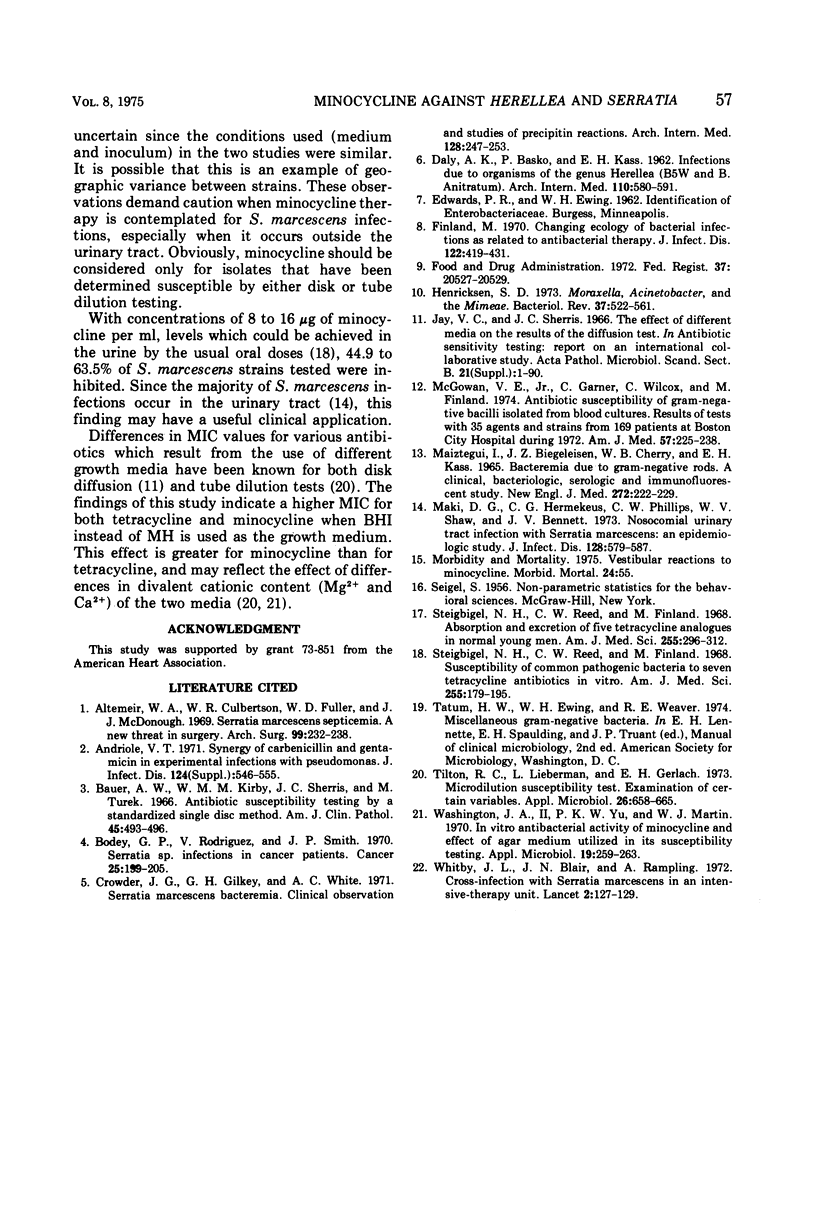Abstract
The activity of minocycline and tetracycline against 23 isolates of Acinetobacter calcoaceticus var. anitratus (syn. Herellea vaginicola) and 178 strains of Serratia marcescens was determined by disk and microdilution methods. The results indicate that minocycline is highly active against this species of Acinetobacter, all but one strain being inhibited by 0.007 μg of the antibiotic per ml. Tetracycline was also active, though to a lesser degree, against A. calcoaceticus. Of the 178 strains of S. marcescens tested, only seven (3.9%) had a minimum inhibitory concentration of 2 μg or less of minocycline per ml. Tetracycline was less active than minocycline against S. marcescens; with 2 μg of tetracycline per ml, only 2 of 152 (1.3%) strains were inhibited. At concentrations of 8 and 16 μg of minocycline per ml, which can be achieved in the urine with the usual doses, 44.9 and 63.5% of S. marcescens strains were inhibited, which implies its possible usefulness for the therapy of urinary tract infection due to this organism.
Full text
PDF



Selected References
These references are in PubMed. This may not be the complete list of references from this article.
- Altemeier W. A., Culbertson W. R., Fullen W. D., McDonough J. J. Serratia marcescens septicemia. A new threat in surgery. Arch Surg. 1969 Aug;99(2):232–238. doi: 10.1001/archsurg.1969.01340140104015. [DOI] [PubMed] [Google Scholar]
- Bauer A. W., Kirby W. M., Sherris J. C., Turck M. Antibiotic susceptibility testing by a standardized single disk method. Am J Clin Pathol. 1966 Apr;45(4):493–496. [PubMed] [Google Scholar]
- Bodey G. P., Rodriguez V., Smith J. P. Serratia sp. infections in cancer patients. Cancer. 1970 Jan;25(1):199–205. doi: 10.1002/1097-0142(197001)25:1<199::aid-cncr2820250128>3.0.co;2-4. [DOI] [PubMed] [Google Scholar]
- Crowder J. G., Gilkey G. H., White A. C. Serratia marcescens bacteremia. Clinical observations and studies of precipitin reactions. Arch Intern Med. 1971 Aug;128(2):247–253. doi: 10.1001/archinte.1971.00310200083008. [DOI] [PubMed] [Google Scholar]
- DALY A. K., POSTIC B., KASS E. H. Infections due to organisms of the genus Herellea. B5W and B. anitratum. Arch Intern Med. 1962 Nov;110:580–591. doi: 10.1001/archinte.1962.03620230026006. [DOI] [PubMed] [Google Scholar]
- Finland M. Changing ecology of bacterial infections as related to antibacterial therapy. J Infect Dis. 1970 Nov;122(5):419–431. doi: 10.1093/infdis/122.5.419. [DOI] [PubMed] [Google Scholar]
- Henriksen S. D. Moraxella, Acinetobacter, and the Mimeae. Bacteriol Rev. 1973 Dec;37(4):522–561. doi: 10.1128/br.37.4.522-561.1973. [DOI] [PMC free article] [PubMed] [Google Scholar]
- MAIZTEGUI J. I., BIEGELEISEN J. Z., Jr, CHERRY W. B., KASS E. H. BACTEREMIA DUE TO GRAM-NEGATIVE RODS. A CLINICAL, BACTERIOLOGIC, SEROLOGIC AND IMMUNOFLUORESCENT STUDY. N Engl J Med. 1965 Feb 4;272:222–229. doi: 10.1056/NEJM196502042720502. [DOI] [PubMed] [Google Scholar]
- Maki D. G., Hennekens C. G., Phillips C. W., Shaw W. V., Bennett J. V. Nosocomial urinary tract infection with Serratia marcescens: an epidemiologic study. J Infect Dis. 1973 Nov;128(5):579–587. doi: 10.1093/infdis/128.5.579. [DOI] [PubMed] [Google Scholar]
- McGowan J. E., Jr, Garner C., Wilcox C., Finland M. Antibiotic susceptibility of gram-negative bacilli isolated from blood cultures. Results of tests with 35 agents and strains from 169 patients at Boston City Hospital during 1972. Am J Med. 1974 Aug;57(2):225–238. doi: 10.1016/0002-9343(74)90447-1. [DOI] [PubMed] [Google Scholar]
- Steigbigel N. H., Reed C. W., Finland M. Absorption and excretion of five tetracycline analogues in normal young men. Am J Med Sci. 1968 May;255:296–312. doi: 10.1097/00000441-196805000-00005. [DOI] [PubMed] [Google Scholar]
- Steigbigel N. H., Reed C. W., Finland M. Susceptibility of common pathogenic bacteria to seven tetracycline antibiotics in vitro. Am J Med Sci. 1968 Mar;255:179–195. doi: 10.1097/00000441-196803000-00005. [DOI] [PubMed] [Google Scholar]
- Tilton R. C., Lieberman L., Gerlach E. H. Microdilution antibiotic susceptibility test: examination of certain variables. Appl Microbiol. 1973 Nov;26(5):658–665. doi: 10.1128/am.26.5.658-665.1973. [DOI] [PMC free article] [PubMed] [Google Scholar]
- Washington J. A., 2nd, Yu P. K., Martin W. J. In vitro antibacterial activity of minocycline and effect of agar medium utilized in its susceptibility testing. Appl Microbiol. 1970 Feb;19(2):259–263. doi: 10.1128/am.19.2.259-263.1970. [DOI] [PMC free article] [PubMed] [Google Scholar]
- Whitby J. L., Blair J. N., Rampling A. Cross-infection with Serratia marcescens in an intensive-therapy unit. Lancet. 1972 Jul 15;2(7768):127–129. doi: 10.1016/s0140-6736(72)91612-1. [DOI] [PubMed] [Google Scholar]


